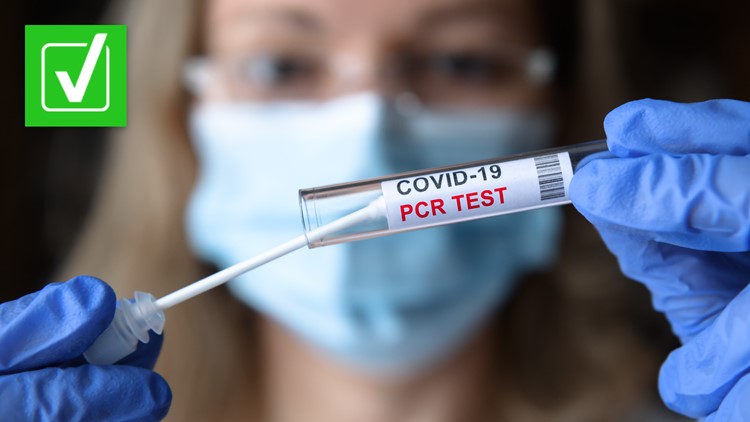Since the start of the COVID-19 pandemic in the United States, over 46 million positive coronavirus test results have been reported to the U.S. Centers for Disease Control and Prevention (CDC).
When it comes to detecting SARS-CoV-2, or the virus that causes COVID-19, the U.S. Food and Drug Administration (FDA) says there are two types of diagnostic tests that can show if a person has an active infection: molecular and antigen. VERIFY viewer Nick wants to know which test is considered the most effective way to detect an active COVID-19 infection.
THE QUESTION
Is the molecular test more effective than the antigen test in detecting COVID-19 infections?
THE SOURCES
- U.S. Food and Drug Administration (FDA)
- U.S. Centers for Disease Control and Prevention (CDC)
- Yale Medicine
- Dr. Gerard Cangelosi, professor of environmental and occupational health sciences at the University of Washington
- Dr. Christopher D. Doern, director of clinical microbiology at Virginia Commonwealth University
- Jason Feldman, CEO of Vault Health
THE ANSWER
Yes, the molecular PCR test is the most accurate way to detect an active COVID-19 infection.
WHAT WE FOUND
According to Yale Medicine, molecular tests, like nucleic acid amplification tests (NAAT) or polymerase chain reaction (PCR) tests, look for genetic material from the SARS-CoV-2 virus by using sophisticated chemicals and equipment to reproduce millions to billions of copies of viral-related DNA from even the smallest sample. Because of that, the molecular test is considered highly sensitive and generally, more accurate, than antigen tests.
Antigen tests, which are sometimes called rapid tests, search for pieces of protein from the virus. Antigen test samples are treated with a reagent and typically analyzed on-site by a healthcare professional. Unlike molecular tests, Yale Medicine says antigen tests require a higher level of virus in the test sample before the test will turn positive, which means that an antigen test may sometimes lead to a false negative.
“Sensitivity measures how often a test correctly delivers a positive result for people with the condition that's being tested,” Yale Medicine says on its website. “A test that's highly sensitive will catch almost anyone who has the disease and not generate a lot of false-negative results.”
There are a variety of ways to collect specimen samples for COVID-19 testing, including nasal swab, throat swab or saliva. Nasal swab samples are collected using a swab that looks similar to a short or long Q-Tip, according to the FDA. There are three types of nasal sample collection methods: anterior nares (nasal), mid-turbinate and nasopharyngeal.
The anterior nares method involves putting a swab three-quarters of an inch into the nostril and twirling it around at least four times to get a sample, according to Yale Medicine. The mid-turbinate method involves placing a soft swab less than one inch straight back into the nostril to collect a sample. For the nasopharyngeal method, a health care professional inserts a long swab deep into a person’s nostril to collect fluid from the back of their nose. Meanwhile, oropharyngeal (throat) swabs are collected by using a swab on the back of the throat and saliva samples are usually collected by spitting into a tube.
Dr. Christopher D. Doern, the director of clinical microbiology at Virginia Commonwealth University, told VERIFY the nasopharyngeal swab can be uncomfortable to some patients but he says it is considered the “best of the best” in terms of its sensitivity.
“This is the gold standard,” said Doern. “We know that it is the best test in terms of picking up the most positives.”
Doern says while the scientific research varies, the nasopharyngeal swab on average usually detects 10 out of 10 positive COVID-19 cases while saliva, for example, may yield eight out of 10 positive COVID-19 cases. But he says you also have to factor in whether a person is showing symptoms or not.
Dr. Gerard Cangelosi, a professor of environmental and occupational health sciences at the University of Washington who has helped develop non-invasive screening methods of COVID-19 detection and diagnosis, says that while the nasopharyngeal swab may be the “gold standard” way to detect a positive case of COVID-19, it’s not necessarily the most practical way to collect specimen samples for various populations.
“Gold standard is typically applied in diagnostics. That term is just used as it's the most sensitive and accurate way to do it, but that doesn't always mean that it's the best way to do it because you have to take practical considerations into account,” Cangelosi told VERIFY. “They're very invasive, they're unpleasant. It's difficult for the patient because it goes basically deep into your nasal pharynx, or basically to the base of your skull. And it's difficult for the health care provider as well because they have to stand right in front of the patient while they're doing this, and patients often cough or sneeze or curse. It's not an easy process.”
According to Cangelosi, “the most critical limiting factor in finding positive COVID-19 cases is the frequency of testing,” not necessarily in the way specimen samples are collected.
“It's not so much where you sample, you need to sample frequently. Somebody who has active disease might test negative one day, then test positive the next day, and then test negative the day after that. It's just because the virus kind of rises and falls during the day,” said Cangelosi. “In order to find people who are capable of transmitting the virus, you really need to test people frequently.”
Cangelosi says he prefers to use less invasive nasal swabs, like the mid-turbinate and anterior methods, while testing because it is easier to collect samples more frequently over the nasopharyngeal method.
“They're a little bit less sensitive but you can collect them more frequently, and if you collect samples and test more frequently, you're going to find more cases,” said Cangelosi.
Jason Feldman, the CEO of Vault Health, a leading virtual healthcare platform, says Vault offers nasal swab and saliva COVID-19 testing options to workplaces and schools nationwide. He says Vault’s priority is making sure they get accurate results from their tests.
“The reason we launched the saliva test is really for facilitating testing with younger kids, families, and people who are doing a test at home where we can be sure that by simply spitting in a tube, we can get a good sample. When you're asked on a self-test basis to take a nasal swab and get your own sample, especially if it's a deeper nasal swab, it's difficult, and it's also difficult to make sure that you're getting a good sampling of biomaterial. If you don't get the right sample. You don't get the right result. We're sure that if you spit in a tube, there's so much viral material in your saliva, that we'll get enough to be able to make sure that the test we give you is an accurate result,” said Feldman.
Yale Medicine says most molecular test specimens are sent to laboratories in order to process the results, which are usually available within a range of one to seven days, depending on location. According to the CDC, laboratory-based tests, like the molecular PCR test, have a “generally high” test sensitivity.
More from VERIFY: Yes, at-home COVID-19 rapid tests are as accurate as rapid tests done at testing sites



